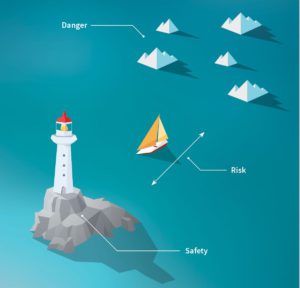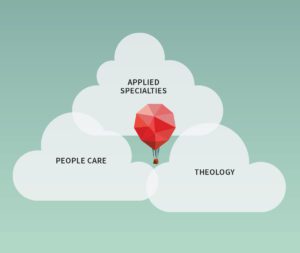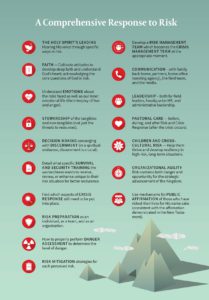
by Anna Hampton
For almost two decades, my husband Neal and I have lived in or near war zones with our children, or in places with active terrorist threats and violent activity. While stress resiliency does increase over time and with experience, we brace ourselves from the newest wave of extremist threats against foreigners here in the capital city in a Middle Eastern country. The threats are the usual—extremists threatening to attack Christians in places where we gather, including former Muslims or foreigners and the local international church.
The local uniformed and plain clothes police have steadily increased their guarding presence on Sunday mornings at our church. During the past year and a half, over nineteen bombs have gone off in our city alone. While we do have responsible risk mitigation procedures in place at the church, we rely on God’s restraining arm to protect our little ones and us while worshipping there.
I write from the perspective of a mom who has lived risk assessment and mitigation for over seventeen years, having personal familiarity with several of the top American security training firms working with mission agencies. This article focuses on some of the necessary elements of cross-cultural risk for a comprehensive and holistic response to the threats which cross-cultural field workers face on a regular basis for the sake of the strategic advancement of his kingdom.
The issue of a Theology of Risk began primarily as a field driven necessity due to the increased numbers of workers going to serve in areas hostile to the Gospel and the resulting violence of kidnappings and murders of untold numbers of global workers. The urgency of understanding and effectively responding to cross-cultural risk has exponentially increased as more and more global workers respond to the call to reach the unreached in dangerous, high-risk places.
A Theology of Risk and a Theology of Suffering, often viewed as synonyms, inherently maintain clear points of overlap and divergence from each other. One major difference is that in risk situations, we have not suffered yet. Risk is the threat of persecution, the threat of suffering, the threat of death.
Yes, all Christ-followers suffer. Jesus tells we will suffer as we follow him. Wisdom means we develop a personal theology of suffering to rely on before going into risk. However, risk asks the question of whether I am called to move (or continue to move) into a place of danger, or if Christ calls me to move to a place of safety.

Suffering may occur in places of safety and danger. Teams should develop this theology before going into risk.
Theology of Risk:
Risk asks whether one is called to move (or continue moving) into a place of danger or to a place of safety.
Bible Background1
There are three different Greek words in the New Testament most often translated with the word “risk.” The three passages include Acts 15:25–26, Romans 16:3–4, and Philippians 2:29–30. Closer inspection of these three Greek words reveals several Hebraic idioms describing risk. The Hebraic idioms give the picture of “walking into a place of death; giving myself over to death; laying down my neck.” It appears that the early Church viewed risk as something we willingly do; those who risked their lives received a call to do so, and risking one’s life is always connected to voluntarily giving up one’s physical life for Jesus Christ.
From these three New Testament passages, we gain a deeper understanding of how the early Church may have thought about risk and what Scriptures they drew on. All three New Testament passages together point to the Exodus 17 passage, where the Israelites fought the Amalekites. From these four passages on risk, we can draw a wealth of information on cross-cultural risk.
- Risking our lives is something we all prepare to do for Christ, but only a few chosen ones receive the call to risk their lives.
- Not risking in certain situations does not automatically mean disobedience to God. The same Bible figures often cited as examples of moving into risk almost always had times when they righteously avoided risk or retreated from danger.
- Instead of focusing on what people in the Bible did in risk (the anecdotal approach), a Holy Spirit-reliant approach focuses on how they heard the Spirit’s voice when called to risk their lives or called to retreat to safety.
- The principle of choosing actions represented by the verse: “wise as serpents and as peaceful as doves” ought to motivate us to mitigate risk. Both Jesus and Paul demonstrated choosing the “big death” not the little one (the one before their time).
- Spirit-led risking our lives involves us in a spiritual battle.
- Spirit-led risking our lives reveals our priestly service.
- Spirit-led risking our lives always partners with the Trinity.
A global worker facing risk often asks the questions of “what shall I do?” and “Shall I go into risk or move towards safety,” and “How do I know?” All too often, we received a “suffering” answer in response to these crucial questions, such as “God works all things together for good…”2
As a young mom taking little children into a place like Kabul, Afghanistan where the Taliban actively began kidnapping and killing faith-based NGO workers (like us), I desired for more than a conceptual answer to navigate my faith response and my emotions about the risks we entered into with little ones for his glory. Cross-cultural risk by definition is not an abstract concept but an event.
A situational answer focuses on the unique risk event, as well as its urgent challenges and major opportunities. A situational answer considers more than just physical danger threat and assessment but addresses the whole situation and the whole person. It engages in the eternal strategy and opportunity, stewardship questions, and the intersection of faith and emotions in risk. In other words, a situational answer helps guide the worker and team in understanding what God strategically is orchestrating in and through the life of that global worker, the team, and the community during the risk situation.

I advocate for a greater consideration of balanced conceptual and situational answers when pastoring workers living in the front line, high risk situations. Our human weakness requires the reminder on a regular basis that God remains sitting on his throne.3 God is not surprised by negative outcomes in the risk situation. We must remember this truth.
However, an effective, faith-strengthening response to a global worker considers a balanced conceptual and situational answer. A dialogue that takes into account all the factors impacting the global worker, and not simply providing a simplified spiritualized answer or a “rational” danger assessment engenders a heart strengthening and a calming effect in the soul of the global worker facing extreme threats.
Risk Assessment and Mitigation
I am deeply grateful for my brothers and sisters who have stepped up to use their professional security backgrounds to strengthen the resiliency of field workers. They have done this by training field workers in how to withstand the pressures of interrogation, avoiding rape, avoiding and surviving kidnapping, hostage survival, learning how to hone awareness of surveillance techniques, developing crisis response team and plans, and so much more. These Christian security training firms remain an incredibly noteworthy and significant resource for the Bride of Christ. We affirm and commend them for what they do.
I deeply benefited when completing a three-day training in Kabul by a Security Training firm visiting Kabul in Spring 2006. My internal stress dramatically decreased, and my personal resiliency significantly improved. The training and equipping helped Neal and me navigate the extremely difficult years that followed in Afghanistan as we led a team of over a hundred expatriates in a complex project in a high-risk, dangerous environment where eternally significant work was and still is going on.
However, practical security, survival training, crisis management are just one of three significant aspects of a holistic risk response. We miss significant areas if we train field workers only in physical danger risk assessment, mitigation techniques, crisis response management. We must find ways to address the intersection of faith, emotions, stewardship, and the role of the Holy Spirit in the risk situation. These are also necessary aspects of a holistic Theology of Risk. Addressing these aspects will help us wisely guide moms, dads, singles, boys, and girls to implement effective endurance strategies on the field.
Researchers have published over one thousand studies on the emotional and psychological human response to risk. We ignore this data to our peril. Research demonstrates when we do not address both the rational-logical danger analysis and the experiential-emotional analysis, our risk assessment and mitigation are seriously flawed. Humans are predictable in risk.
Additionally, “Research shows that how we experience emotions in risk directly impacts our risk perceptions, judgments, and decision-making. It also shows that in a wide range of contexts the emotional reaction at the moment is more influential in determining choice than the rational evaluation of the options conducted beforehand.”4 For example, we learn from the research that “fear causes us to think the risks are much higher; whereas anger causes us to perceive the risks as much lower.”5
I propose that we consider the field of cross-cultural risk preparation, assessment, and mitigation to have three primary overlapping areas: applied specialties, people care, and theology.

Teams should learn how and when to integrate all three areas of cross-cultural risk for their unique context.
A comprehensive approach to risk provides the necessary tools and training intersecting with all three areas of a holistic risk strategy. In the Risk Assessment and Management Training (RAM Training) Neal and I provide, we help global workers and their teams learn how and when to integrate all three sub-specialties in a guided way. Developing a guided action plan through training helps cut through the confusion of risk assessment and management and integrates the essential elements of a holistic approach to risk for their unique cross-cultural context and presenting risks.
Neal and I guide field workers and their teams to discern what additional training will better prepare a worker and the team for the unique risks they face. We created a global list of the three areas shown in the graphic above, listing diverse types of risk-related trainings, security training firms, security analysis and information management companies, crisis management organizations, people care specialties, and helpful books we recommend in all three areas.
One of the common weaknesses in current risk preparation models entails the requirement for teams to prepare for risks they do not face by implementing a “too general” risk assessment strategy. For example, teams receive an assignment of fifty things to mitigate against, instead of teaching how to do tactical risk assessment and mitigation for their specific situation and project goals.
One Country Director consulted Neal on finding a designated hostage negotiator. The country in which he lives has had NO foreign hostages in the modern era, yet the home office of this busy ministry leader mandated he follow the risk preparation protocol. It required him to waste a half day on mitigating a risk that did not exist in his situation. Living in risk is exhausting! We must exercise caution and not add superfluous risk assessment and mitigation to already overworked team leaders.

Risk assessment and mitigation must evaluate what the felt hazards are (what the team fears), but also number statistically verifiable hazards (what has been happening), and incorporate predicted risks based on a multi-stream security analysis and information gathering (what could happen). Calculating risk incorporates all factors that contribute to the possibility of the risk event occurring, the actual risk event, and the predicted outcomes (good and bad) if that risk event occurs.
Risk assessment and mitigation needs to be done constantly and quickly (not every six months, but in some situations, almost daily) in a changing risk environment so we can make decisions in a rapidly degrading environment. Risk assessment techniques should not be too labor intensive but involve the analysis of the severity, demographic proximity, geographic proximity, and frequency of the risk.
The RAM Training (Risk Assessment and Management) we developed incorporates the following:
- Equips participants with a scalable risk management protocol—one easily adapted to any risk environment.
- Provides a guide for using the Bible to discern calling in risk rather than an anecdotal Biblical model.
- Helps workers discern how they have heard the Holy Spirit’s voice in the past, and how they can better hear His leading through seven unique ways He may speak in the risk event;
- Guides both leaders and individual team members in how to make sure they have responsibly and comprehensively calculated risk from rational, emotional, and spiritual perspectives.
- Equips workers with the key components of decision-making and discernment in risk.
- Facilitates field workers in developing endurance strategies that work for them (even in lock-down situations);
- Augments other stress-resilience and security training by helping field workers discern which risks they hear the calling to minister in; in short, when to stay and when to go.
- Equips participants to better communicate about risk with other field workers, their children, their leadership, and sending partners.
We need to ease the burden of risk assessment and increase the confidence of individuals, teams, and agencies that they have prepared their people well and know what questions to ask as they walk with people in risk. It is imperative that individuals and teams calculate each risk event as holistically as possible. If the front-line leader uses a tool characterized as either too complicated, too labor-intensive, or too simplistic, we have not enabled them to do responsible risk management, and the tool will remain under-utilized.
Some agencies are susceptible to making two common mistakes in risk assessment and mitigation: ignoring genuine threats, or failing to re-calculate the risk in dynamic risk environments. Agencies with high-risk tolerance are especially prone to ignore uncertainties or neglect to account for what they don’t know. Making these assumptions is dangerous and irresponsible because people’s lives are at stake.
Risks must be calculated and recalculated for each unique cultural context since risk is an event. One of the most valuable faith strengthening activities we can do in risk is to take precious time and energy in the risk situation to assess it and know as much as we can about what risks we are facing. This often results in increased resiliency and improves our capacity to demonstrate loving humble responses in the face of real evil.
In short, comprehensive risk assessment and mitigation enables us to face the risk, name the risk, analyze ourselves in light of the risk and God’s calling in that situation, do everything reasonable to responsibly steward all resources entrusted to us, and accept the worst (and best) outcomes. This is how field workers can best carry on and face the worst horrors the gates of hell throw at us and not be overcome by them.
Teams (and their agencies) are obliged to become “risk literate” and “risk agile” to care for their people well in risk but also respond to the incredible opportunities facing our generation to reach the world for Christ.
Paul and Risk Mitigation
We see the Apostle Paul too often used as a “spiritual club” against workers in this way: “Paul did this, so you should do this.” It is imperative we focus instead on how Paul heard the Holy Spirit’s voice in each risk situation and made decisions. We see from Paul’s life that he used four different risk mitigation tactics. He avoided risk, transferred it to others, limited it, and accepted it. He prayerfully discerned which one God called him to use each time.
Risk Myths
We have realized over the years that the global Church uses at least fourteen “risk myths.” We recognized some of these negatively impacting our resiliency. For example, one dangerous myth commonly repeated is, “You are never safer than when you are in the center of God’s will.” Trauma, suffering, and death quite often accompany cross-cultural risk. Once what one has feared occurs, and we experience that God does not play by our “man-made rules,” a faith crisis may result. Part of cross-cultural risk literacy recognizes what myths we unknowingly embrace and then addresses these with Scriptural truth.
Conclusion
The meaning of this study reveals there is no time for neutrality or ambivalence about risk. We are in a global spiritual battle for the souls of men, women, boys, and girls. The call to risk one’s life is an honor given by God for the worker to steward. It requires a careful listening to his voice on what to do because it also involves stewardship of kingdom resources.
We honor our Savior and those who risk their lives on a daily basis for the sake of Christ’s kingdom by increasing our skills in empathetically and situationally pastoring those in risk, helping them thrive, develop resiliency, and endure joyfully. Effective risk assessment and management enables field workers to take full advantage of the opportunities in risk so that his kingdom advances in exceedingly dark areas.
May future generations describe us as men and women who wisely took Spirit-led risks for his glory and for love for all those who have yet to hear the Good News.
1. My methodology followed the example by Dr. Kenneth Bailey’s unique tri-pronged approach. I utilized Rabbi Hillel’s 1st Century Rabbinical Hermeneutic outlined by Brad Young, ancient commentaries on the texts examined, as well as modern tools of exegetical scholarship.
2. Romans 8:28.
3. Psalm 47:8; Revelation 7:15.
4. Hampton, Anna, Dr. Facing Danger: A Guide Through Risk. New Prague, MN: Zendagi Press, 2016. Quote from Dr. Charles Schaefer.
And Breakwell, Glynis M. The Psychology of Risk. 2nd ed. Cambridge: Cambridge University Press. Kindle Location 338.
5. Breakwell, Glynis M. The Psychology of Risk, 2nd ed. Cambridge University Press. Kindle Location 3567.
